This is an old revision of this page, as edited by The Image Editor (talk | contribs) at 17:21, 6 October 2020 (Added photographs in campaign section). The present address (URL) is a permanent link to this revision, which may differ significantly from the current revision.
Revision as of 17:21, 6 October 2020 by The Image Editor (talk | contribs) (Added photographs in campaign section)(diff) ← Previous revision | Latest revision (diff) | Newer revision → (diff) For related races, see 1840 United States elections.
| |||||||||||||||||||||||||||||
294 members of the Electoral College 148 electoral votes needed to win | |||||||||||||||||||||||||||||
|---|---|---|---|---|---|---|---|---|---|---|---|---|---|---|---|---|---|---|---|---|---|---|---|---|---|---|---|---|---|
| Turnout | 80.2% | ||||||||||||||||||||||||||||
| |||||||||||||||||||||||||||||
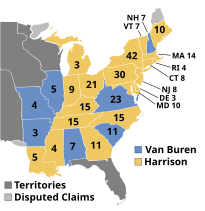 | |||||||||||||||||||||||||||||
| |||||||||||||||||||||||||||||
The 1840 United States presidential election was the 14th presidential election, held from Friday, October 30 to Wednesday, December 2, 1840. Economic recovery from the Panic of 1837 was incomplete, and Whig nominee William Henry Harrison defeated incumbent President Martin Van Buren of the Democratic Party. The election marked the first of two Whig victories in presidential elections.
In 1839, the Whigs held a national convention for the first time. The 1839 Whig National Convention saw 1836 nominee William Henry Harrison defeat former Secretary of State Henry Clay and General Winfield Scott. Van Buren faced little opposition at the 1840 Democratic National Convention, but controversial Vice President Richard Mentor Johnson was not re-nominated. The Democrats thus became the only major party since the passage of the Twelfth Amendment to fail to select a vice presidential nominee.
Referencing vice presidential nominee John Tyler and Harrison's participation in the Battle of Tippecanoe, the Whigs campaigned on the slogan of "Tippecanoe and Tyler Too." With Van Buren weakened by economic woes, Harrison won a popular majority and 234 of 294 electoral votes. Voter participation surged as white male suffrage became nearly universal, and a contemporary record of 42.4% of the voting age population voted for Harrison. Van Buren's loss made him the third president to lose re-election.
The Whigs did not enjoy the benefits of victory. The 67-year-old Harrison was the oldest U.S. president elected until Ronald Reagan won the 1980 presidential election. Harrison died a little more than a month after inauguration. Harrison was succeeded by John Tyler, who unexpectedly proved not to be a Whig. While Tyler had been a staunch supporter of Clay at the convention, he was a former Democrat, a passionate supporter of states' rights, and effectively an independent. As President, Tyler blocked the Whigs' legislative agenda and was expelled from the Whig Party.
Nominations
Whig Party nomination
Main article: 1839 Whig National Convention| 1840 Whig Party ticket | |||||||||||||||||||||||||||||
| William Henry Harrison | John Tyler | ||||||||||||||||||||||||||||
|---|---|---|---|---|---|---|---|---|---|---|---|---|---|---|---|---|---|---|---|---|---|---|---|---|---|---|---|---|---|
| for President | for Vice President | ||||||||||||||||||||||||||||
 |
 | ||||||||||||||||||||||||||||
| Former U.S. Senator from Ohio (1825–1828) |
Former U.S. Senator from Virginia (1827–1836) | ||||||||||||||||||||||||||||
| Campaign | |||||||||||||||||||||||||||||
Three years after Democrat Martin Van Buren was elected President in the election of 1836 over three Whig candidates, the Whigs met in national convention determined to unite behind a single candidate. The convention was chaired by Isaac C. Bates of Massachusetts and James Barbour of Virginia presided over the convention. The party nominated the popular retired general William Henry Harrison of Ohio for president, the most successful of the three Whig presidential candidates from the previous election. Harrison won a close victory on the convention's fifth ballot against party founder Henry Clay and General Winfield Scott. Harrison, though a slave-owner and aristocrat, was perceived as being simple and a commoner. The convention nominated former Senator John Tyler from Virginia for vice president. The two would go on to win the 1840 presidential election by defeating Van Buren.
Because Harrison (born in Virginia) was considered a Northerner (as a resident of Ohio), the Whigs needed to balance the ticket with a Southerner. They also sought a Clay supporter to help unite the party after Clay's loss on the balloting. Tyler was finally chosen by the convention after several Southern Clay supporters had been approached but refused. Tyler had previously been the running-mate of Hugh Lawson White and Willie Person Mangum during the four-way Whig campaign at the previous election.
Democratic Party nomination
Main article: 1840 Democratic National Convention | |||||||||||||||||||||||||||||
| Martin Van Buren | |||||||||||||||||||||||||||||
|---|---|---|---|---|---|---|---|---|---|---|---|---|---|---|---|---|---|---|---|---|---|---|---|---|---|---|---|---|---|
| for President | |||||||||||||||||||||||||||||
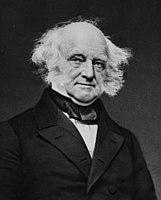 | |||||||||||||||||||||||||||||
| 8th President of the United States (1837–1841) | |||||||||||||||||||||||||||||
| Campaign | |||||||||||||||||||||||||||||
Van Buren, the incumbent president, was re-nominated in Baltimore in May 1840.
While the party refused to re-nominate the incumbent vice-president, Richard M. Johnson, they were unable to agree on an alternative running mate at the convention, and decided not to nominate one; as of 2020, this is the only time since the passage of the 12th Amendment in 1804 that a major party has failed to do so.
This is also one of only two elections where a major party did not have a vice-presidential candidate on their ticket on Election Day; the other was in 1912 when the incumbent vice-president, James S. Sherman (Republican), died six days before the election.
In the electoral college, the Democratic vice-presidential votes were divided among Johnson, Littleton W. Tazewell, and James K. Polk.
Anti-Masonic Party nomination
After the negative views of Freemasonry among a large segment of the public began to wane in the mid 1830s, the Anti-Masonic Party had begun to disintegrate. Its leaders began to move one by one to the Whig party. Party leaders met in September 1837 in Washington, D.C., and agreed to maintain the party. The third Anti-Masonic Party National Convention was held in Philadelphia on November 13–14, 1838. By this time, the party had been almost entirely supplanted by the Whigs. The delegates unanimously voted to nominate William Henry Harrison for president (who the party had supported for president the previous election along with Francis Granger for vice president) and Daniel Webster for vice president. However, when the Whig National Convention nominated Harrison with John Tyler as his running mate, the Anti-Masonic Party did not make an alternate nomination and ceased to function and was fully absorbed into the Whigs by 1840.
| Presidential vote | Vice Presidential vote | ||
|---|---|---|---|
| William Henry Harrison | 119 | Daniel Webster | 119 |
Liberty Party nomination
The Liberty Party was announced in November 1839, and first gathered in Warsaw, New York. Its first national convention took place in Arcade on April 1, 1840.
The Liberty Party nominated James G. Birney, a Kentuckian, former slaveholder, and prominent abolitionist, for president while Thomas Earle of Pennsylvania was selected as his running mate.
General election
Campaign

In the wake of the Panic of 1837, Van Buren was widely unpopular, and Harrison, following Andrew Jackson's strategy, ran as a war hero and man of the people while presenting Van Buren as a wealthy snob living in luxury at the public expense. Although Harrison was comfortably wealthy and well educated, his "log cabin" image caught fire, sweeping all sections of the country.
Harrison avoided campaigning on the issues, with his Whig Party attracting a broad coalition with few common ideals. The Whig strategy overall was to win the election by avoiding discussion of difficult national issues such as slavery or the national bank and concentrate instead on exploiting dissatisfaction over the failed policies of the Van Buren administration with colorful campaigning techniques.
Log cabin campaign of William Henry Harrison
Main article: William Henry Harrison 1840 presidential campaignHarrison was the first president to campaign actively for office. He did so with the slogan "Tippecanoe and Tyler too". Tippecanoe referred to Harrison's military victory over a group of Shawnee Native Americans at a river in Indiana called Tippecanoe in 1811. For their part, Democrats laughed at Harrison for being too old for the presidency, and referred to him as "Granny", hinting that he was senile. Said one Democratic newspaper: "Give him a barrel of hard cider, and ... a pension of two thousand a year ... and ... he will sit the remainder of his days in his log cabin."

Whigs took advantage of this quip and declared that Harrison was "the log cabin and hard cider candidate", a man of the common people from the rough-and-tumble West. They depicted Harrison's opponent, President Martin Van Buren, as a wealthy snob who was out of touch with the people. In fact, it was Harrison who came from a family of wealthy planters, while Van Buren's father was a tavernkeeper. Harrison however moved to the frontier and for years lived in a log cabin, while Van Buren had been a well-paid government official.
Nonetheless, the election was held during the worst economic depression in the nation's history, and voters blamed Van Buren, seeing him as unsympathetic to struggling citizens. Harrison campaigned vigorously and won.
Results
Harrison won the support of western settlers and eastern bankers alike. The extent of Van Buren's unpopularity was evident in Harrison's victories in New York, the president's home state, and in Tennessee, where Andrew Jackson himself had come out of retirement to stump for his former vice-president.
Few Americans were surprised when Van Buren lost in the electoral vote by 234 to 60, but many were amazed by the closeness of the popular vote: of 2.4 million votes cast, Van Buren lost by only 146,000, and a shift of less than 25,000 to Van Buren in Georgia, Mississippi, New York, and Pennsylvania would have left the electoral college in a 147–147 tie, forcing a contingent election in the House of Representatives.
Given all the circumstances, it is surprising that the Democrats performed as well as they did.
Of the 1,179 counties/independent cities making returns, Harrison won in 699 (59.29%) while Van Buren carried 477 (40.46%). Three counties (0.25%) in the South split evenly between Harrison and Van Buren.
Harrison's victory won him precious little time as chief executive of the United States. After giving the longest inauguration speech in U.S. history (lasting about 1 hour and 45 minutes, in cold weather and rain), Harrison served only one month as president before dying of pneumonia on April 4, 1841. This was also the first election in US history in which a candidate won more than a million popular votes.
This was the last election where Indiana voted for the Whigs. It is also the only election where the Whigs won Maine, Michigan, and Mississippi. The election was also the last time that Mississippi voted against the Democrats until 1872, the last in which Indiana did so until 1860 and the last in which Maine and Michigan did so until 1856.
| Presidential candidate | Party | Home state | Popular vote | Electoral vote |
Running mate | |||
|---|---|---|---|---|---|---|---|---|
| Count | Percentage | Vice-presidential candidate | Home state | Electoral vote | ||||
| William Henry Harrison | Whig | Ohio | 1,275,390 | 52.88% | 234 | John Tyler | Virginia | 234 |
| Martin Van Buren | Democratic | New York | 1,128,854 | 46.81% | 60 | Richard Mentor Johnson | Kentucky | 48 |
| Littleton Waller Tazewell | Virginia | 11 | ||||||
| James Knox Polk | Tennessee | 1 | ||||||
| James Gillespie Birney | Liberty | New York | 6,797 | 0.31% | 0 | Thomas Earle | Pennsylvania | 0 |
| Other | 767 | 0.00% | — | Other | — | |||
| Total | 2,411,808 | 100% | 294 | 294 | ||||
| Needed to win | 148 | 148 | ||||||
Source (Popular Vote): Leip, David. "1840 Presidential Election Results". Dave Leip's Atlas of U.S. Presidential Elections. Retrieved July 27, 2005. Source (Electoral Vote): "Electoral College Box Scores 1789–1996". National Archives and Records Administration. Retrieved July 31, 2005.
The popular vote figures exclude South Carolina where the Electors were chosen by the state legislature rather than by popular vote.
| |||||||||||||||||||||||||
| ||||||||||||||||||||
Geography of results
Cartographic gallery
-
 Map of presidential election results by county
Map of presidential election results by county
-
 Map of Whig presidential election results by county
Map of Whig presidential election results by county
-
 Map of Democratic presidential election results by county
Map of Democratic presidential election results by county
-
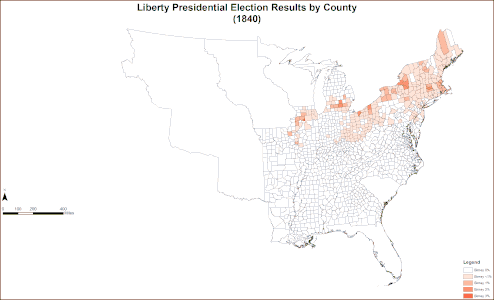 Map of Liberty presidential election results by county
Map of Liberty presidential election results by county
-
 Map of "Other" presidential election results by county
Map of "Other" presidential election results by county
-
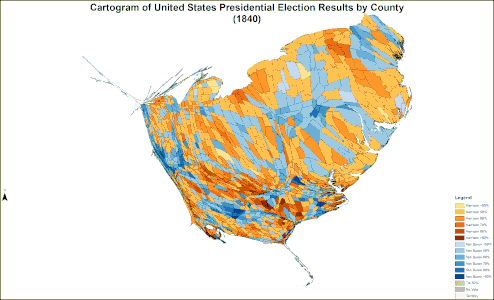 Cartogram of presidential election results by county
Cartogram of presidential election results by county
-
 Cartogram of Whig presidential election results by county
Cartogram of Whig presidential election results by county
-
 Cartogram of Democratic presidential election results by county
Cartogram of Democratic presidential election results by county
-
 Cartogram of Liberty presidential election results by county
Cartogram of Liberty presidential election results by county
-
 Cartogram of "Other" presidential election results by county
Cartogram of "Other" presidential election results by county
Results by state
Source: Data from Walter Dean Burnham, Presidential ballots, 1836–1892 (Johns Hopkins University Press, 1955) pp 247–257.
| States/districts won by Van Buren |
| States/districts won by Harrison/Tyler |
| William Henry Harrison Whig |
Martin Van Buren Democratic |
James G. Birney Liberty |
Margin | State Total | ||||||||||||||
|---|---|---|---|---|---|---|---|---|---|---|---|---|---|---|---|---|---|---|
| State | electoral votes |
# | % | electoral votes |
# | % | electoral votes |
# | % | electoral votes |
# | % | # | |||||
| Alabama | 7 | 0001361828,515 | 45.62 | - | 0004866933,996 | 54.38 | 7 | no ballots | -5,481 | -8.76 | 62,511 | AL | ||||||
| Arkansas | 3 | 5,160 | 43.58 | - | 6,679 | 56.42 | 3 | no ballots | -1,519 | -12.84 | 11,839 | AR | ||||||
| Connecticut | 8 | 31,598 | 55.55 | 8 | 25,281 | 44.45 | - | no ballots | 6,317 | 11.10 | 56,879 | CT | ||||||
| Delaware | 3 | 5,967 | 54.99 | 3 | 4,872 | 44.89 | - | no ballots | 1,095 | 10.10 | 10,852 | DE | ||||||
| Georgia | 11 | 40,339 | 55.78 | 11 | 31,983 | 44.22 | - | no ballots | 8,356 | 11.56 | 72,322 | GA | ||||||
| Illinois | 5 | 45,574 | 48.91 | - | 47,441 | 50.92 | 5 | 160 | 0.17 | - | -1,867 | -2.01 | 93,175 | IL | ||||
| Indiana | 9 | 65,302 | 55.86 | 9 | 51,604 | 44.14 | - | no ballots | 13,698 | 11.72 | 116,906 | IN | ||||||
| Kentucky | 15 | 58,488 | 64.20 | 15 | 32,616 | 35.80 | - | no ballots | 25,872 | 28.40 | 91,104 | KY | ||||||
| Louisiana | 5 | 11,296 | 59.73 | 5 | 7,616 | 40.27 | - | no ballots | 3,680 | 19.46 | 18,912 | LA | ||||||
| Maine | 10 | 46,612 | 50.23 | 10 | 46,190 | 49.77 | - | no ballots | 422 | 0.46 | 92,802 | ME | ||||||
| Maryland | 10 | 33,528 | 53.83 | 10 | 28,752 | 46.17 | - | no ballots | 4,776 | 7.66 | 62,280 | MD | ||||||
| Massachusetts | 14 | 72,852 | 57.44 | 14 | 52,355 | 41.28 | - | 1,618 | 1.28 | - | 20,497 | 16.16 | 126,825 | MA | ||||
| Michigan | 3 | 22,933 | 51.71 | 3 | 21,096 | 47.57 | - | 321 | 0.72 | - | 1,837 | 4.14 | 44,350 | MI | ||||
| Mississippi | 4 | 19,515 | 53.43 | 4 | 17,010 | 46.57 | - | no ballots | 2,505 | 6.86 | 36,525 | MS | ||||||
| Missouri | 4 | 22,954 | 43.37 | - | 29,969 | 56.63 | 4 | no ballots | -7,015 | -13.26 | 52,923 | MO | ||||||
| New Hampshire | 7 | 26,310 | 43.88 | - | 32,774 | 54.66 | 7 | 872 | 1.45 | - | -6,464 | -10.78 | 59,956 | NH | ||||
| New Jersey | 8 | 33,351 | 51.74 | 8 | 31,034 | 48.15 | - | 69 | 0.11 | - | 2,317 | 3.59 | 64,454 | NJ | ||||
| New York | 42 | 226,001 | 51.18 | 42 | 212,733 | 48.18 | - | 2,809 | 0.64 | - | 13,268 | 3.00 | 441,543 | NY | ||||
| North Carolina | 15 | 46,567 | 57.68 | 15 | 34,168 | 42.32 | - | no ballots | 12,399 | 15.36 | 80,735 | NC | ||||||
| Ohio | 21 | 148,157 | 54.10 | 21 | 124,782 | 45.57 | - | 903 | 0.33 | - | 23,375 | 8.53 | 273,842 | OH | ||||
| Pennsylvania | 30 | 144,010 | 50.00 | 30 | 143,676 | 49.88 | - | 340 | 0.12 | - | 334 | 0.12 | 288,026 | PA | ||||
| Rhode Island | 4 | 5,278 | 61.22 | 4 | 3,301 | 38.29 | - | 42 | 0.49 | - | 1,977 | 22.93 | 8,621 | RI | ||||
| South Carolina | 11 | no popular vote | no popular vote | 11 | no popular vote | - | - | - | SC | |||||||||
| Tennessee | 15 | 60,194 | 55.66 | 15 | 47,951 | 44.34 | - | no ballots | 12,243 | 11.32 | 108,145 | TN | ||||||
| Vermont | 7 | 32,445 | 63.90 | 7 | 18,009 | 35.47 | - | 319 | 0.63 | - | 14,436 | 28.43 | 50,773 | VT | ||||
| Virginia | 23 | 42,639 | 49.35 | - | 43,757 | 50.65 | 23 | no ballots | -1,120 | -1.30 | 86,394 | VA | ||||||
| TOTALS: | 294 | 1,275,583 | 52.87 | 234 | 1,129,645 | 46.82 | 60 | 7,453 | 0.31 | - | 145,938 | 6.05 | 2,412,694 | US | ||||
| TO WIN: | 148 | |||||||||||||||||
Close states
States where the margin of victory was under 5%:
- Pennsylvania 0.12%
- Maine 0.46%
- Virginia 1.3%
- Illinois 2.01%
- New York 3.0%
- New Jersey 3.59% (tipping point state)
- Michigan 4.14%
Campaign songs/slogans
Harrison

Problems playing this file? See media help.

Problems playing this file? See media help.
Van Buren
- Rockabye, baby, Daddy's a Whig
- When he comes home, hard cider he'll swig
- When he has swug
- He'll fall in a stu
- And down will come Tyler and Tippecanoe.
- Rockabye, baby, when you awake
- You will discover Tip is a fake.
- Far from the battle, war cry and drum
- He sits in his cabin a'drinking bad rum.
- Rockabye, baby, never you cry
- You need not fear of Tip and his Ty.
- What they would ruin, Van Buren will fix.
- Van's a magician, they are but tricks.
Election paraphernalia
-
 Harrison "Tippecanoe Club" ribbon
Harrison "Tippecanoe Club" ribbon
-
 Ribbon for Harrison political rally
Ribbon for Harrison political rally
-
 Ribbon for Danvers, Mass. delegation to Harrison Rally, Bunker Hill, 1840; engraved by George Girdler Smith
Ribbon for Danvers, Mass. delegation to Harrison Rally, Bunker Hill, 1840; engraved by George Girdler Smith
-
 Delegate badge, Democratic convention
Delegate badge, Democratic convention
-
 Cover of Boston Harrison Club's Harrison Melodies, 1840
Cover of Boston Harrison Club's Harrison Melodies, 1840
Electoral college selection
| Method of choosing electors | State(s) |
|---|---|
| Each Elector appointed by state legislature | South Carolina |
| Each Elector chosen by voters statewide | (all other States) |
In popular culture
In the film Amistad, Van Buren (played by Nigel Hawthorne) is seen campaigning for re-election. These scenes have been criticized for their historical inaccuracy.
See also
- History of the United States (1789–1849)
- Second Party System
- 1840 United States House of Representatives elections
- 1840 and 1841 United States Senate elections
- Inauguration of William Henry Harrison
References
- ^ Between 1828–1928: "Voter Turnout in Presidential Elections: 1828–2008". The American Presidency Project. UC Santa Barbara. Retrieved November 9, 2012.
- https://americanhistory.si.edu/democracy-exhibition/vote-voice/getting-vote/demanding-vote/white-manhood-suffrage
- "About US President William Henry Harrison". What is USA News. September 17, 2013. Archived from the original on April 13, 2015. Retrieved September 16, 2012.
- Watson, Harry L. (2006). Liberty and Power: The Politics of Jacksonian America. New York: Farrar, Straus and Giroux. p. 226. ISBN 0-8090-6547-9.
- Boston Harrison Club. Harrison melodies: Original and selected. Boston: Weeks, Jordan and company, 1840. Google books
- Foner, Eric (March 1998). "The Amistad Case in Fact and Film".
Further reading
- Chambers, William Nisbet. "The Election of 1840" in Arthur M. Schlesinger, Jr. (ed.) History of American Presidential Elections, 1789–1968 (1971) vol 2; analysis plus primary sources
- Cheathem, Mark. R. The Coming of Democracy: Presidential Campaigning in the Age of Jackson (Johns Hopkins University Press, 2018)
- Ellis, Richard J. Old Tip vs. the Sly Fox: The 1840 Election and the Making of a Partisan Nation (U of Kansas Press, 2020) online review
- Formisano, Ronald P. "The new political history and the election of 1840," Journal of Interdisciplinary History, Spring 1993, Vol. 23 Issue 4, pp. 661–82 in JSTOR
- Gunderson, Robert Gray (1957). The Log-Cabin Campaign. Lexington: University of Kentucky Press.
- Greeley, Horace (1868). Recollections of a Busy Life.
- Greeley's description of the 1840 election is posted on Wikisource.
- Holt, Michael F. "The Election of 1840, Voter Mobilization, and the Emergence of the Second American Party System: A Reappraisal of Jacksonian Voting Behavior", in Holt and John McCardell, eds. A Master's Due: Essays in Honor of David Herbert Donald (1986); emphasizes economic factors; See Formisano (1993) for criticism
- Holt, Michael F. (1999). The Rise and Fall of the American Whig Party: Jacksonian Politics and the Onset of the Civil War. Oxford University Press. ISBN 0-19-505544-6.
- Leahy, Christopher J. President without a Party: The Life of John Tyler (LSU, 2020), a major scholarly biography; excerpt also online review
- Shade, William G. "Politics and Parties in Jacksonian America", Pennsylvania Magazine of History and Biography Vol. 110, No. 4 (Oct. 1986), pp. 483–507 online
- Zboray, Ronald J., and Mary Saracino Zboray. "Whig Women, Politics, and Culture in the Campaign of 1840: Three Perspectives from Massachusetts", Journal of the Early Republic Vol. 17, No. 2 (Summer, 1997), pp. 277–315 in JSTOR
Primary sources
- Chester, Edward W A guide to political platforms (1977) online
- Porter, Kirk H. and Donald Bruce Johnson, eds. National party platforms, 1840-1964 (1965) online 1840-1956
External links
- United States presidential election of 1840 at the Encyclopædia Britannica
- Presidential Election of 1840: A Resource Guide from the Library of Congress
- "The Campaign of 1840: William Henry Harrison and Tyler, Too" high school level lesson plans and documents
- "Overview of Whig National Convention of 1839". Our Campaigns.com. Retrieved February 12, 2018.
- 1840 popular vote by counties
- How close was the 1840 election? — Michael Sheppard, Massachusetts Institute of Technology
- Election of 1840 in Counting the Votes
| (← 1836) 1840 United States presidential election (1844 →) | |||||
|---|---|---|---|---|---|
| Whig Party (Convention) |
| ||||
| Democratic Party (Convention) |
| ||||
| State and district results of the 1840 United States presidential election | ||
|---|---|---|
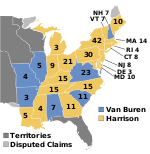 | ||